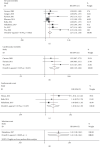Low Testosterone Level and Risk of Adverse Clinical Events among Male Patients with Chronic Kidney Disease: A Systematic Review and Meta-Analysis of Cohort Studies
- PMID: 36124237
- PMCID: PMC9482512
- DOI: 10.1155/2022/3630429
Low Testosterone Level and Risk of Adverse Clinical Events among Male Patients with Chronic Kidney Disease: A Systematic Review and Meta-Analysis of Cohort Studies
Abstract
The phenomenon of low testosterone level is extremely common in male patients with chronic kidney diseases (CKDs). This meta-analysis aimed to evaluate whether the low circulating testosterone could independently predict adverse outcomes among male patients with chronic kidney diseases (CKDs). The data till May 2022 were systematically searched from Pubmed, Web of Science, and Embase from inception. Studies meeting the PICOS (population, intervention/exposure, control/comparison, outcomes, and study design) principles were included in this meta-analysis. Study-specific effect estimates were pooled using fixed-effects (I 2 > 50%) or random-effects models (I 2 < 50%). Ultimately, 9 cohort studies covering 5331 patients with CKDs were involved in this meta-analysis. The results suggested that per 1-standard deviation (SD) decrease in total testosterone independently increased the risk of all-cause mortality by 27% [hazard risk (HR) 1.27, 95% confidence interval (CI) 1.16-1.38], cardiovascular mortality by 100% (HR 2.00, 95% CI 1.39-2.86), cardiovascular events by 20% (HR 1.20, 95% CI 1.04-1.39), and infectious events by 41% (HR 1.41, 95% CI 1.08-1.84). Besides, with per 1-SD decrease in free testosterone, the risk of overall adverse events increased by 66% (HR 1.66, 95% CI 1.34-2.05). Stratified analyses indicated that the negative relationship of the total testosterone with all-cause death risk was independent of factors involving age, race, body mass index, diabetes, hypertension, C-reactive protein, creatinine, and sex hormone binding globulin. In conclusion, it was identified that low endogenous testosterone could serve as an independent predictor of adverse clinical events among male patients with CKDs.
Copyright © 2022 Li Li et al.
Conflict of interest statement
The authors declare no conflicts of interest.
Figures






Similar articles
-
Effects of a gluten-reduced or gluten-free diet for the primary prevention of cardiovascular disease.Cochrane Database Syst Rev. 2022 Feb 24;2(2):CD013556. doi: 10.1002/14651858.CD013556.pub2. Cochrane Database Syst Rev. 2022. PMID: 35199850 Free PMC article.
-
Impact of residual disease as a prognostic factor for survival in women with advanced epithelial ovarian cancer after primary surgery.Cochrane Database Syst Rev. 2022 Sep 26;9(9):CD015048. doi: 10.1002/14651858.CD015048.pub2. Cochrane Database Syst Rev. 2022. PMID: 36161421 Free PMC article.
-
Risk-reducing bilateral salpingo-oophorectomy in women with BRCA1 or BRCA2 mutations.Cochrane Database Syst Rev. 2018 Aug 24;8(8):CD012464. doi: 10.1002/14651858.CD012464.pub2. Cochrane Database Syst Rev. 2018. PMID: 30141832 Free PMC article.
-
Beta-blockers in patients without heart failure after myocardial infarction.Cochrane Database Syst Rev. 2021 Nov 5;11(11):CD012565. doi: 10.1002/14651858.CD012565.pub2. Cochrane Database Syst Rev. 2021. PMID: 34739733 Free PMC article.
-
Smoking cessation for secondary prevention of cardiovascular disease.Cochrane Database Syst Rev. 2022 Aug 8;8(8):CD014936. doi: 10.1002/14651858.CD014936.pub2. Cochrane Database Syst Rev. 2022. PMID: 35938889 Free PMC article.
Cited by
-
Differences in the epidemiology, management and outcomes of kidney disease in men and women.Nat Rev Nephrol. 2024 Jan;20(1):7-20. doi: 10.1038/s41581-023-00784-z. Epub 2023 Nov 20. Nat Rev Nephrol. 2024. PMID: 37985869 Review.
-
Sex hormone binding globulin (SHBG) serum levels and insulin resistance in men on chronic hemodialysis.Diabetol Metab Syndr. 2024 Jul 16;16(1):166. doi: 10.1186/s13098-024-01406-9. Diabetol Metab Syndr. 2024. PMID: 39014506 Free PMC article.
-
Understanding human aging and the fundamental cell signaling link in age-related diseases: the middle-aging hypovascularity hypoxia hypothesis.Front Aging. 2023 Jun 13;4:1196648. doi: 10.3389/fragi.2023.1196648. eCollection 2023. Front Aging. 2023. PMID: 37384143 Free PMC article.
-
Creatinine and Cystatin C: A Measure of Renal Function in Men With Testosterone-Induced Muscle Hypertrophy.Am J Mens Health. 2024 Sep-Oct;18(5):15579883241286654. doi: 10.1177/15579883241286654. Am J Mens Health. 2024. PMID: 39402920 Free PMC article.
References
-
- Brar A., Markell M. Impact of gender and gender disparities in patients with kidney disease. Current Opinion in Nephrology and Hypertension . 2019;28(2):178–182. - PubMed
Publication types
MeSH terms
Substances
LinkOut - more resources
Full Text Sources
Medical
Research Materials

